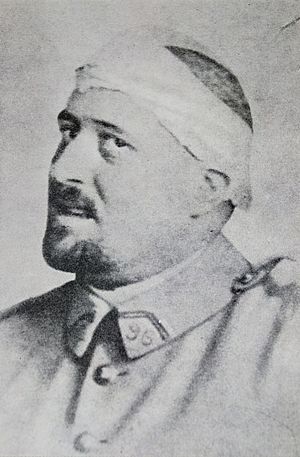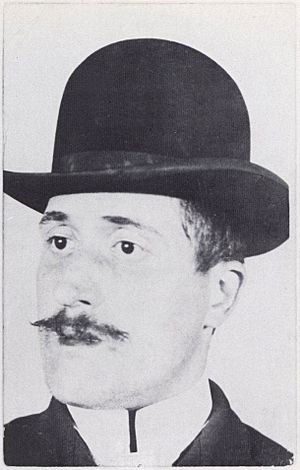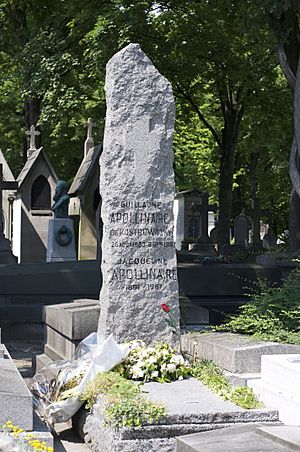Guillaume Apollinaire facts for kids
Quick facts for kids
Guillaume Apollinaire
|
|
|---|---|

Photograph of Guillaume Apollinaire in spring 1916 after a shrapnel wound to his temple
|
|
| Born | Wilhelm Albert Włodzimierz Apolinary Kostrowicki 26 August 1880 Rome, Italy |
| Died | 9 November 1918 (aged 38) Paris, France |
| Occupation | Poet, writer, art critic |
| Signature | |
Guillaume Apollinaire (born August 26, 1880 – died November 9, 1918) was a famous French poet, writer, and art critic. He was born in Rome, Italy, and had Polish and Belarusian family roots.
Apollinaire is seen as one of the most important poets of the early 1900s. He strongly supported a new art style called Cubism. He also helped start another art movement called Surrealism. He even created the word "cubism" in 1911 to describe the new art. Later, in 1917, he used "surrealism" to describe the works of a composer named Erik Satie. He also named the art style Orphism in 1912. His play Les mamelles de Tirésias (1917) is considered one of the first Surrealist plays.
Apollinaire also worked as a journalist and art critic for several newspapers and magazines. He helped start an art and literature magazine called Les Soirées de Paris in 1912.
Sadly, Apollinaire was hurt during World War I. Two years later, in 1918, he died at age 38 from the Spanish flu pandemic.
Contents
Early Life and Moving to Paris
Guillaume Apollinaire was born in Rome, Italy. His birth name was Wilhelm Albert Włodzimierz Apolinary Kostrowicki. Growing up, he spoke French, Italian, and Polish. When he was a teenager, he moved to France and started using the name Guillaume Apollinaire.
His mother, Angelika Kostrowicka, was from a noble family in Poland. His grandfather was a general in the Russian army. Apollinaire's father is not known for sure. He might have been Francesco Costantino Camillo Flugi d'Aspermont, an aristocrat from Switzerland.
Apollinaire eventually moved to Paris. He became a very popular person in the city's art scene. He made friends with many famous artists and writers.
Friends and Artistic Connections
In Paris, Apollinaire became friends with many important artists. These included Pablo Picasso, Henri Rousseau, Gertrude Stein, and Marcel Duchamp. He also worked with people like André Breton and Erik Satie.
He was especially close to the artist Marie Laurencin. Many people thought she was his inspiration for his work. Apollinaire was interested in new ideas and supported fairness for everyone.
Apollinaire and Cubism
Apollinaire was a big supporter of Cubism. This was a new art style where artists broke objects into geometric shapes. In 1909 or 1910, his friend Jean Metzinger painted a Cubist portrait of Apollinaire. Apollinaire was proud to be the first person to have a Cubist portrait painted.
In 1911, Apollinaire joined a group of Cubist artists called the Puteaux Group. He even gave the main speech at a very important Cubist art show in 1912.
A Mix-Up at the Louvre
In 1911, something strange happened. Police arrested Apollinaire because they thought he helped steal the famous Mona Lisa painting. They also thought he helped steal some ancient Egyptian statues from the Louvre Museum.
He was held for a week, but then he was released. It turned out that a former secretary of Apollinaire had stolen the statues. This person had even given one statue back to a newspaper. Apollinaire also mentioned his friend Picasso, who was questioned too, but he was also found innocent. The Mona Lisa was actually stolen by an Italian painter named Vincenzo Peruggia. He acted alone and was caught two years later.
World War I and Later Life
Apollinaire joined the army and fought in World War I. In 1916, he was seriously injured when a piece of shrapnel hit his head. He never fully recovered from this wound. He wrote his play Les Mamelles de Tirésias while he was getting better.
During this time, he also created the word "Surrealism". He used it in the notes for a ballet called Parade, which was first performed in 1917. He also published an important essay about new art ideas. Apollinaire was also known for recognizing the writer Marquis de Sade, whose works later influenced the Dada and Surrealist art movements.
Apollinaire's health was weakened by his war injury. He died from the influenza during the Spanish flu pandemic in 1918. He is buried in the Père Lachaise Cemetery in Paris.
Apollinaire in Pop Culture
Guillaume Apollinaire has been shown in television. For example, the actor Seth Gabel played him in the 2018 TV series Genius. This show was about the life of Pablo Picasso.
Notable Works
Apollinaire wrote many different kinds of works, including poetry, novels, and plays. Here are some of his well-known works:
Poetry Collections
- L'enchanteur pourrissant (1909)
- Le Bestiaire ou Cortège d'Orphée (1911)
- Alcools (1913)
- Calligrammes, poèmes de la paix et de la guerre 1913–1916 (1918)
Novels
- Les Onze Mille Verges ou les Amours d'un hospodar (1907)
- Les Exploits d'un jeune Don Juan (1911)
Short Story Collections
- L'Hérèsiarque et Cie (1910)
- Le Poète assassiné (1916)
Plays
- Les Mamelles de Tirésias (1917)
See also
 In Spanish: Guillaume Apollinaire para niños
In Spanish: Guillaume Apollinaire para niños
- Prix Guillaume Apollinaire (a poetry prize named after him)
Images for kids
-
Muse Inspiring the Poet. Portrait of Apollinaire and Marie Laurencin, by Henri Rousseau, 1909









